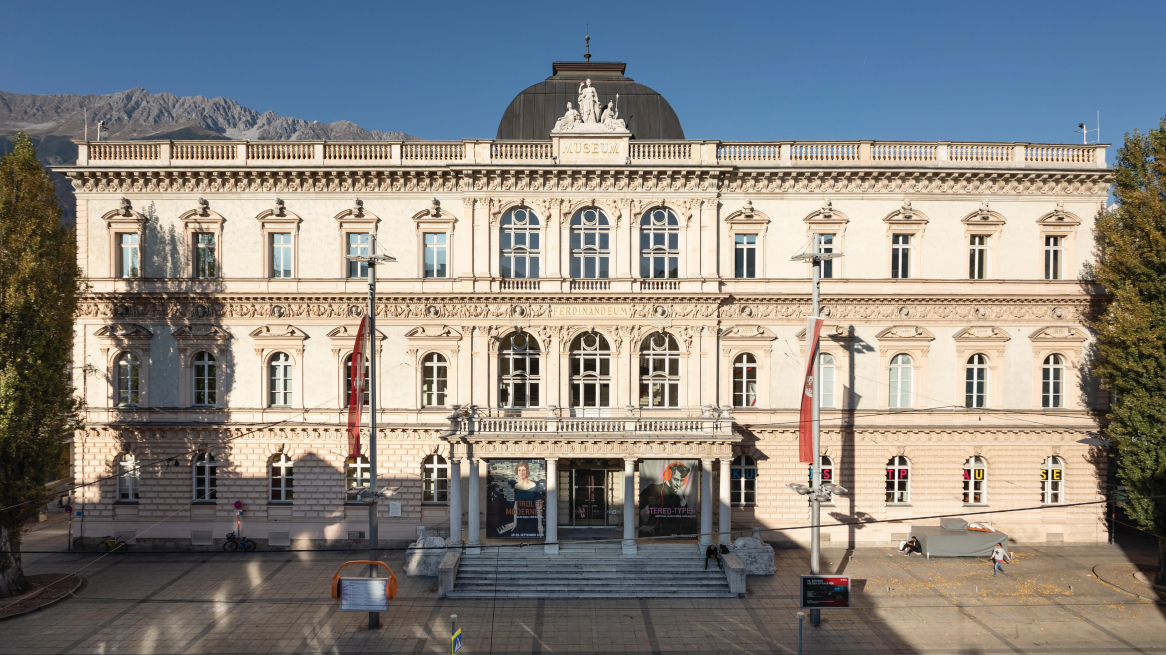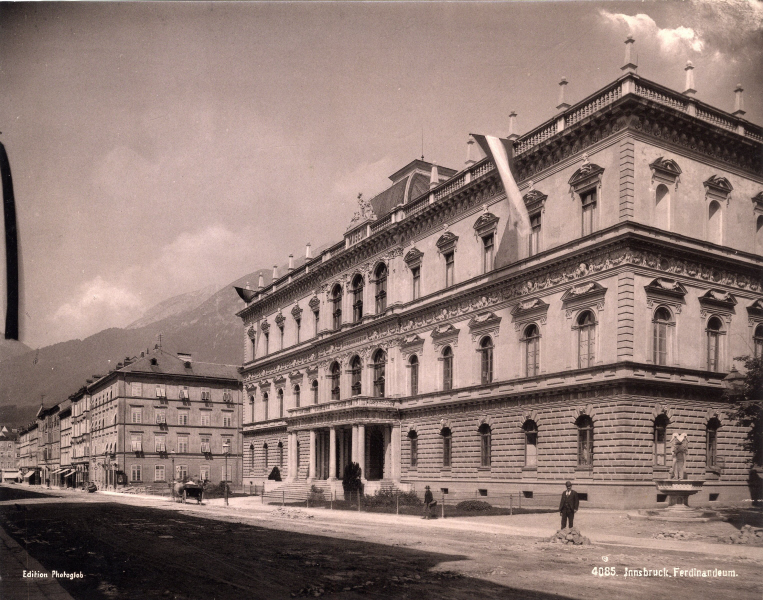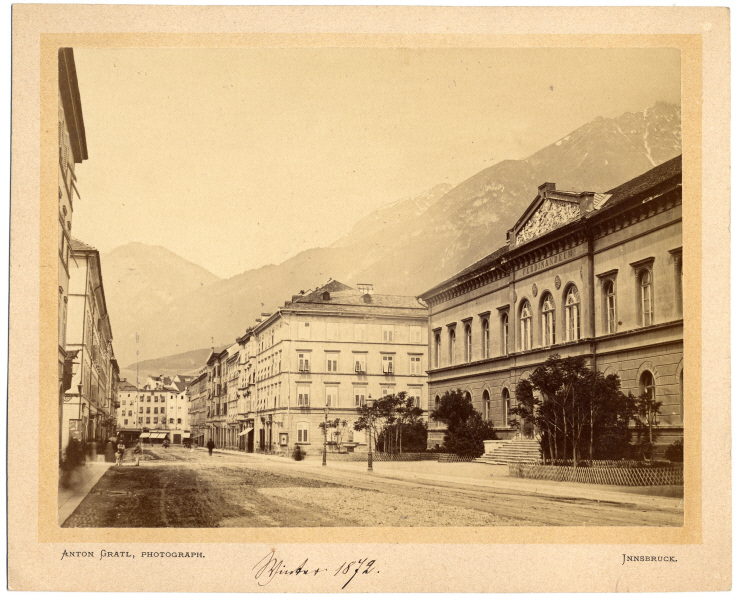
Anyone walking through Museumstraße today will think it has always been there: the Tyrolean Provincial Museum Ferdinandeum. The three-story building in neo-Renaissance style is set back somewhat. The wide marble staircase, lined by two sphinxes and under a column-supported balcony, also underlines the special role of this building in the street.
The main building of the Tyrolean Provincial Museums in Museumstraße on the occasion of the opening of the Goethe exhibition in 2020. Photo: © Wolfgang Lackner
For art and science
Front view of the Ferdinandeum around 1890, the stately entrance portal still without sphinxes. Photo: © TLM
Between the first and second floors shines golden "Ferdinandeum", to the left and right of it busts of famous Tyrolean artists, among them as the only woman the native Vorarlberg Angelika Kauffmann. In the window gables of the second floor are the portrait heads of important Tyrolean scientists and poets - from Oswald von Wolkenstein to Hermann von Gilm. The three-meter-high sculpture of "Tyrolia" towers above the ornate façade , with the letters "Museum" at its feet.
This year, the Tyrolean Provincial Museum celebrates its 200th anniversary. It is the flagship of the Tiroler Landesmuseen Betriebsgesellschaft m.b.H. (TLM) with its five houses and a dozen collections, the flagship of the local museums and exhibition houses. And next to the Tyrolean Regional Theater, the most important cultural institution in Innsbruck, not only historically, an institution. It was founded in 1823 by influential citizens of the provincial capital - with the imperial blessing and with the decisive participation of the Governor of Tyrol, Karl Graf von Chotek. In the first year of its existence, the association already had 379 members; today it has around 2,500.
200 years Ferdinandeum
View of Museumstraße, on the right the still two-story Tyrolean Provincial Museum Ferdinandeum. Photo from the year 1872, © TLM
Initially, the museum did not have its own premises. Collections and presentation were initially housed in the Wilten Abbey, then in today's Faculty of Theology in Universitätsstraße. The "Tyrolean National Museum", as it was still called at that time, was to collect, preserve, present and research. Namely, everything that was relevant to the historical Tyrol (until the end of the First World War, South Tyrol and Trentino were also territorially part of it).
No wonder that the premises quickly became too small and plans were made for a museum building of their own. The opportunity was favorable, as a new street was built in the "Angerzellgründen" ( Angerzellgasse is still a reminder of this today) and the area was thus opened up for the expansion of the city. The museum was to be the first building to be erected on Museumstrasse. Archduke Ferdinand, who gave the museum its name, arrived for the laying of the foundation stone in 1842.
In the following decades, the museum was to undergo numerous extensions, an east wing was added, the west wing was extended, and an additional storey was added. After the war, the bomb damage was repaired.
Five houses, one roof
Ewa Raczykowska, a student at the University of Applied Arts, took a close look at a collection of hats at the Tyrolean Regional Museums as part of the exhibition „Im Detail“.
The last major renovations and additions were completed in 2003. They brought 2,250 square meters of additional usable space. Another milestone followed in 2018, when the TLM's Collection and Research Center (SFZ) in Hall began operations. Since then, the collection holdings, which have long since numbered several million objects, have been housed there, as well as a central research center.
Since 2007, the Tiroler Landesmuseen Betriebsgesellschaft m.b.H. (TLM) has been in charge of operations; its shareholders are the Province of Tyrol and the Ferdinandeum Association. Including the Tirol Panorama with the Kaiserjägermuseum, the Museum im Zeughaus, the Tyrolean Folk Art Museum and the Hofkirche, the TLM has five museums. The SFZ houses twelve collections - from archaeology to the Tyrolean Folk Song Archive.
Artifacts, scientific and historical objects, art and cultural objects from about 30,000 years of history, and thus one of the largest regional collections in Austria. Only a fraction of the treasures can be seen in the TLM's permanent and special exhibitions. The TLM's fundamental task - collecting, preserving, presenting and researching - has not changed to this day.
Behind the scenes
200 years of the Tyrolean Landesmuseum Ferdinandeum also means 200 years of conservation and restoration of the valuable objects collected. For the first time, a look behind the scenes of this fascinating and multifaceted field of activity is offered by the exhibition „Im Detail. Die Welt der Konservierung und Restaurierung“which can be seen at the Ferdinandeum in Museumstraße until June 25, 2023.
The transport of art objects and cultural assets is a delicate matter. Conservators create the appropriate concepts.
Architect Christian Höller architecturally designed the exhibition „Im Detail“, which runs until June.
This is the first such comprehensive exhibition on the subject in Austria, created in close cooperation with the University of Applied Arts in Vienna. The latter offers training courses in the subject of restoration. With the help of countless examples from the various specialties, visitors can see which materials are particularly sensitive, what damage can occur, how they are treated, which scientific methods are used and when restoration is carried out in the traditional way. In short, what conservators otherwise do "in secret."
"You don't normally see us, although we are involved in every exhibition," Laura Resenberg, head of the department, told us at the opening of the exhibition in November 2022. Conservators ensure that objects are properly conserved, they inspect and restore them for exhibitions, and they pack them in such a way that the precious objects are not damaged during transport (for example, as loans). The protocol alone, which borrowing museums have to fill out, comprises several pages with detailed requirements regarding packaging, transport, hanging and environmental conditions.
Let there be light
Possibilities for damage are countless, such as moisture, mold or moth infestation. The damage that light can do to paper, fabric or paint is remarkable in itself. Among other things, the exhibition contains a list of different light intensities. For example, the lux value is 130,000 lx under clear skies and at the peak of the sun, and 750 lx at dusk, while the Federal Office for the Protection of Monuments recommends 50 l x as a guideline for exhibitions of textiles, graphics, books or leather, and just 120 lx for paintings. In addition, examples of where light damage has occurred and how it can best be treated.
Every museum has an emergency box. It contains everything that is needed for immediate measures in the event of a disaster.
One of the most important goals of conservators is to prevent damage from occurring in the first place. But every museum is equipped for emergencies. TLM employees have experienced everything from air conditioning blackouts to floods.
Particularly memorable: the emergency box with various materials for the "first aid" of objects. Like a first-aid kit for treating an emergency, it contains all the tools and materials needed for immediate measures. Such an emergency box is located in every museum, adapted to the central collection elements there. It must be easy to transport, the location easily accessible and known to the staff. This is just one of many aspects of conservation and restoration that the exhibition „Im Detail“ highlights.
200 and 50
The redesigned permanent exhibition in the Zeughaus will open in fall 2023. Rendering: © Büro Münzing
On the occasion of the round birthday of the Ferdinandeum, there is still a whole series of events that show us what treasures the TLM holds. And what significance this museum has for the city of Innsbruck, the province of Tyrol. For example, the Museum im Zeughaus will celebrate its 50th anniversary in the fall of 2023 with the reopening of the display collection. In the former armory of Emperor Maximilian, objects from the historical collection will then once again trace the history of Tyrol.
The renovation of the main building of the Ferdinandeum in Museumstraße, which is planned for the 200th anniversary, is still a long time coming.
Tyrolean State Museum Ferdinandeum
Museumstraße 15
6020 Innsbruck
Tel. +43 512 59489
www.tiroler-landesmuseen.at
Registration for guided tours: anmeldung@tiroler-landesmuseen.at
For an overview of exhibitions in Innsbruck, see the calendar of events at innsbruck.info.
Photos, unless otherwise indicated: © Susanne Gurschler
Header image: © Innsbruck Tourismus/Mario Webhofer
Rate this article
Show me the location on the map
Innsbruck has captured her heart, and the view of the Nordkette mountains soothes her soul. A journalist, non-fiction author, bookworm, amateur photographer, dog owner and mountain walker #ghostsofinnsbruck
Similar articles
The museum in Innsbruck's Arsenal "Museum im Zeughaus" was reopened on April 6,…
The Ferdinandeum regional museum is open until June 30, 2024, with exhibitions and events. Then a…
A purely Tyrolean film project aims to shed new light on the novel story of probably…
With the Alpine Jitterbugs, Innsbruck has a club that is passionately dedicated to swing dancing. The Alpine…












